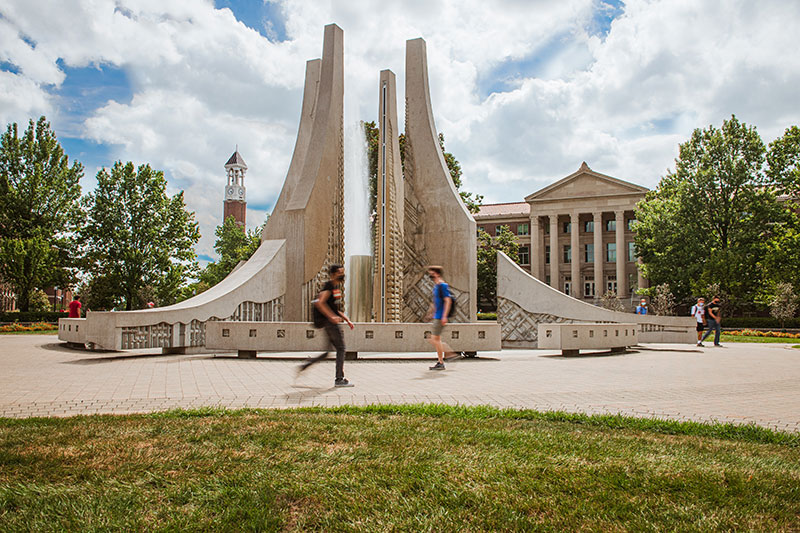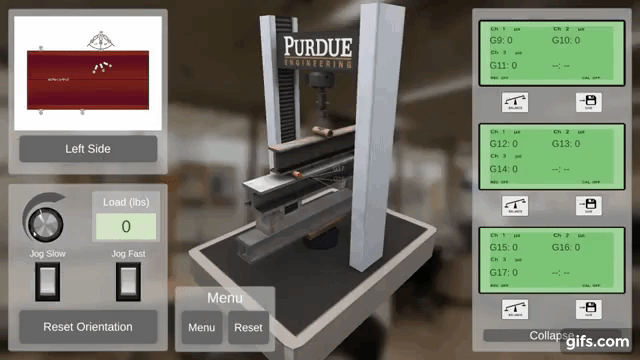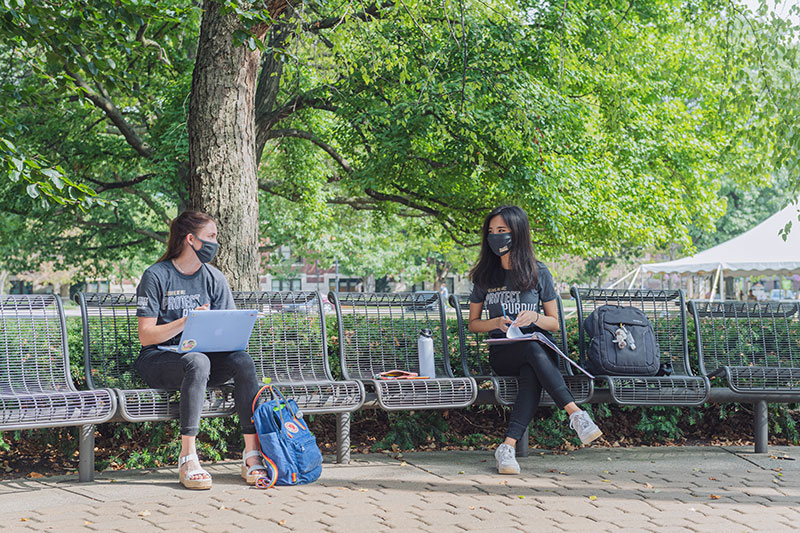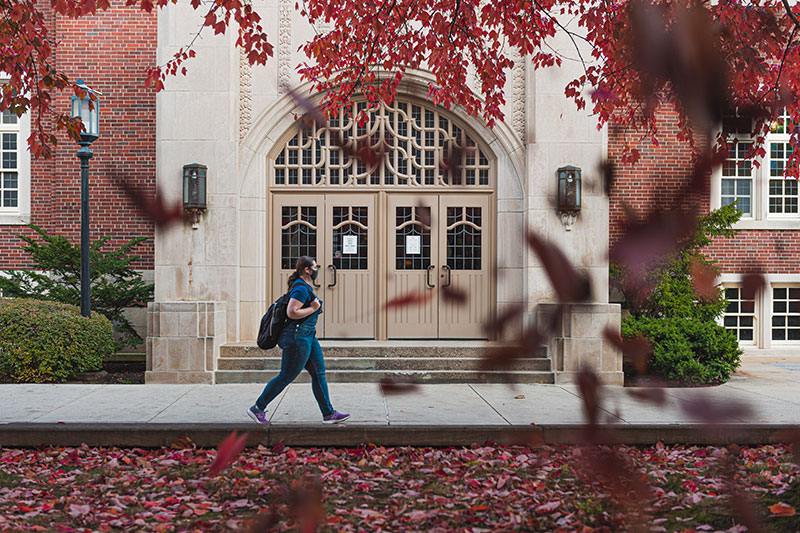June 22, 202
Instruction during pandemic provides foundation for future STEM education

Purdue University is transforming the first-year experience for students in science and engineering utilizing digital tools such as machine learning and virtual laboratories. The pilot program was done with support from the Charles Koch Foundation. (Purdue University photo/Rebecca McElhoe)
Online courses during pandemic provided wealth of data about how first-year science, engineering students learn; lessons to be used for years to come
WEST LAFAYETTE, Ind. — University-level science and engineering courses were modified during the pandemic year, and it is unlikely they will ever fully return to what they were before the events of 2020.
At Purdue University, campus leaders saw an opportunity not only to prepare for the 2020-21 academic year, but also to update and improve higher education for the next generation of students.
"All of us, in both our personal and professional lives, had to learn new ways to be flexible," said Purdue Provost Jay Akridge. "That was certainly true here at Purdue, where we developed new tools that allow us to achieve that. These new tools won’t replace our residential learning experience but will enhance it and expand access to it. And I think that flexibility in higher education is something that is going to endure past the time of COVID-19 and will benefit students for many years to come."
With a hefty reliance on experiential, hands-on learning — think chemistry labs — universities had no doubt that the pandemic would change courses for first-year science and engineering students.
Purdue is a longtime leader in transformative educational techniques — the university created the first School of Engineering Education in the nation. In the summer of 2020, the university launched a pilot project for more than 3,000 first-year science and engineering students to develop new techniques and technologies that would allow it to, if not rethink higher education, then redirect it.
"We already had years of experience with new approaches such as flipped classrooms, experiential learning and virtual laboratories — so much so that other universities often send teams of faculty members to our campus to observe what we are doing," Akridge said. "We believe so strongly in the power of residential education, but what that looks like may be different going forward. What we've done is build flexibility into our first-year science and engineering education.
"It may be that exceptional high school students want to get an early start and take some of this advanced material while they're still in high school. It may be that a student moves into industry and wants to continue taking some of their classes online and then come back to campus. Maybe a student didn't achieve the grade they wanted in one of their first-year courses and wants to repeat it. These new online tools give our students that flexibility."
The new approaches are part of a yearlong pilot program, which emphasizes effective student-to-student networks, even for online students; data science techniques, including machine learning and artificial intelligence; and virtual, yet still hands-on laboratory instruction.
The pilot program is being supported by a $2.3 million grant from the Charles Koch Foundation (CKF), which provides grants to more than 300 colleges and universities nationwide. The foundation is dedicated to breaking barriers that stand in the way of people realizing their potential.
“Purdue is a leader in driving innovations that help learners unlock their potential,” said Ryan Stowers, CKF executive director. “Their dedication to empowering students ensures that they have access to an education that is meaningful and relevant to them. We believe this initiative holds significant promise for the future of learning and are excited to support its progress.”
The funding from CKF was used to redirect 45 first-year courses in Purdue’s College of Science and 10 first-year courses in the College of Engineering. This involved more than 60 faculty members, said Peristera Paschou, associate dean for online and graduate education in the College of Science.
"The redevelopment of the entire sequence of first-year courses in science and engineering provides great opportunities for expanding access," she said.
Alina Alexeenko, associate dean for undergraduate education in the College of Engineering and professor of aeronautics and astronautics and chemical engineering, said the new approaches allowed students to succeed even during a very difficult year.
"We just finished a well-being survey of our first-year students, and we found that the stress and anxiety levels are significantly higher than what we usually see for college students at this age. It's a very stressful time," she said. "But after the first semester, the probation rates were slightly lower than last year, and grades went up slightly this year. And this is criterion-based grading, so there is no grade inflation here."

Virtual labs at Purdue University allow first-year students to practice their techniques before they enter a real laboratory, and also allow students to explore and tinker with chemicals or equipment that would be too dangerous for them to use otherwise. (Purdue University photo/Purdue Envision Center) Download
Virtual labs have fewer boundaries
A key to the success of the pilot project were the virtual labs. Purdue had begun implementing some virtual lab classes in 2017; the initial virtual labs were created by Michael Sangid, Purdue's Elmer F. Bruhn Associate Professor of Aeronautics and Astronautics, professor of materials engineering, and Dean's Fellow for Virtual Labs, and visiting associate professor Alberto Mello.
The onset of the pandemic, however, turned that effort up to full volume. According to Alexeenko, during the 2020–21 academic year, the virtual labs were implemented for more than 3,000 first-year science and engineering students.
According to Sangid, the virtual labs have advantages over in-person labs by removing physical restrictions on when students can use the labs or have access to pieces of equipment.
"The virtual labs also offer more opportunities to interact with equipment, which may be limited with large lab group sizes, offer integration with physics-based computer simulation and computational modeling software to compare against experimental results, and provide easier supervised feedback on experiments," he said.
Assisting the effort was Purdue's Envision Center, which developed virtual facilities and animations in just a couple of months.
Some of the virtual labs are completely online; some work as a flipped classroom where students can practice lab techniques online before attempting them in a real laboratory; and some remote laboratories instruct students in how to do simple experiments at home using inexpensive USB-connected instruments.
The virtual labs also provide more opportunity for creativity because cost and safety are less of an issue.
"In virtual labs, students can speed up time to watch something age, mix chemicals or perform experiments that would be too dangerous to do in a traditional laboratory," Alexeenko said. "Students can also safely tinker and explore on their own timeline and not have to leave the lab when the class time is over."
Jonathan Rienstra-Kiracofe, associate professor of practice in the Department of Chemistry, worked with the Envision Center to create a virtual calorimetrics lab for nearly 3,500 students in the 2020-21 academic year.
"The experiment was all online," Rienstra-Kiracofe said. "The students used the simulation to collect data virtually and then performed analysis of the data in an online lab report. The simulation data was all entirely derived from actual calorimetry experiments conducted by our chemistry prep lab staff, specifically as a basis for the simulation."
He says that because the virtual lab was developed at Purdue, instead of by a publisher or other third party, the department can easily add new data and further develop the simulation for use in Purdue’s general chemistry program.
"I think it is likely that the number of students engaging with the simulation was likely greater than at most any other school," he said.
The course Physics 172: Modern Mechanics combined hands-on experiments and virtual simulation for the laboratory portion of the course, says Carina Rebello, assistant professor of physics and astronomy. In this course, students rented lab kits that included a sensor, such as for force and motion, to collect data, then share the data with small groups and model the physical phenomena.
"Using these tools, students are able to answer questions and complete laboratory reports," she said.
Use of the virtual labs will continue to expand at Purdue. In the summer of 2021, faculty members from 10 disciplines are developing new virtual labs under Sangid’s leadership. This effort is part of the funding from CKF, and the new labs are expected to be deployed by the 2022–23 academic year.

At Purdue University, online portions of courses in first-year science and engineering allow instructors to collect data about how students are learning in a manner that would not be feasible in a traditional classroom setting. The data will be used to help students be more successful in their classes. (Purdue University photo/ Rebecca McElhoe) Download
Using the data science funnel
For instruction, the innovations being worked on are less obvious to the students but no less sophisticated. Moving portions of some courses online allowed Purdue to collect data about how students learn in science and engineering in a manner that would not be feasible in a traditional classroom setting. Researchers are now working through the data science "funnel" of processing data for certain courses, using machine learning to identify patterns in the data, and eventually aiming to use artificial intelligence to provide recommendations to both instructors and students on how to improve based on the identified student patterns.
Christopher Brinton, assistant professor of electrical and computer engineering, is leading the data science and machine learning components of the project.
He points out that in a traditional course, professors get a view of what students know — which educators call "knowledge state mapping" — through exams, homework, other assessments, and personal interactions. Interacting with the students is useful to understanding how the “knowledge state” may be evolving between less frequent assessments. But in-person interactions are harder to replicate in an online environment. He hopes that analyzing how students interact with the course materials and with each other can provide instructors with a more frequent view of how much students are learning in online settings.
“I hope that this research will uncover underlying patterns in how students watch lecture videos and interact in discussion forums and how these patterns may be signals of whether learning is taking place as expected or not in an online course," Brinton said.
Such tools have been used in higher education before, but always in much more limited tests, such as individual classes, said Kerrie Douglas, assistant professor of engineering education.
"Certainly, we're not the only ones doing machine learning with education. What's unique about what Purdue is doing is that instead of studying one or two classes, we're doing it at scale across many first-year courses and thousands of students," she said. "This work isn’t only for the scientific community; our goal is to provide meaningful information instructors can use. For example, how can we help instructors foster an engaging online community with a volume of students this large? Our team is working on visualization tools that would take the machine learning results and make them accessible to instructors.”

Purdue University has long been a leader in transformative educational techniques — the university created the first School of Engineering Education in the nation. Now, new techniques developed during the pandemic will be made available to instructors at other institutions. (Purdue University photo/ Rebecca McElhoe) Download
Benefits to higher education
Donna Riley, Purdue's Kamyar Haghighi Head of the School of Engineering Education, says that before the pandemic, more than once per month Purdue hosted in-person visits from interested colleagues from around the world who wanted to learn more about first-year programs at Purdue. She expects this new program to drive more interest.
"First-year programs at Purdue have enjoyed global attention for years, and these recent innovations are no exception," Riley said. "It’s too early to tell where these particular innovations will travel, but already folks have attended our workshops on how to teach actively online, and I would expect many other first-year programs to adopt and adapt these innovations as they have others."
About Purdue University
Purdue University is a top public research institution developing practical solutions to today’s toughest challenges. Ranked the No. 5 Most Innovative University in the United States by U.S. News & World Report, Purdue delivers world-changing research and out-of-this-world discovery. Committed to hands-on and online, real-world learning, Purdue offers a transformative education to all. Committed to affordability and accessibility, Purdue has frozen tuition and most fees at 2012-13 levels, enabling more students than ever to graduate debt-free. See how Purdue never stops in the persistent pursuit of the next giant leap at https://purdue.edu/
Writer, Media contact: Steve Tally, steve@purdue.edu, @sciencewriter
Source: Jay Akridge, akridge@purdue.edu, @jayakridge
Ryan Stowers, Charles Koch Foundation (media contact Ewan Watt, ewan.watt@ckf.org, @ewancwatt)
Peristera Paschou, ppaschou@purdue.edu
Alina Alexeenko, alexeenk@purdue.edu, @rgd_art
Michael Sangid, msangid@purdue.edu
Jonathan Rienstra-Kiracofe, jonrk@purdue.edu, @Jon_RK1
Carina Rebello, rebelloc@purdue.edu
Christopher Brinton, cgb@purdue.edu, @c_brinton
Kerrie Douglas. douglask@purdue.edu
Donna Riley, riley@purdue.edu
Journalists visiting campus: Journalists should follow Protect Purdue protocols and the following guidelines:
- Campus is open, but the number of people in spaces may be limited. We will be as accommodating as possible, but you may be asked to step out or report from another location.
- To enable access, particularly to campus buildings, we recommend you contact the Purdue News Service media contact listed on the release to let them know the nature of the visit and where you will be visiting. A News Service representative can facilitate safe access and may escort you on campus.
- Correctly wear face masks inside any campus building, and correctly wear face masks outdoors when social distancing of at least six feet is not possible.
Note to Journalists: Photos of students at Purdue University are available on this Google Drive. Journalists visiting campus should follow visitor health guidelines.

